Duranium/Tritanium Double Hull
More actions
The current hull design used for Star Fleet vessels is a double hull system known as the Tritanium – Duranium double hull. While tritanium and duranium are in the name of this hull type, they are not the only materials used. Both the inner and outer hull is composed of various materials arranged in multiple layers. Both the inner and outer hulls are arranged in four distinct layers.
The Outer hull is the primary protective shell for the internal volume of the ship and depending on the exact design of the ship’s hull can be up to 50.21 cm in thickness. The inner hull acts as a second level of protection for the interior volume and is of 19.25 cm in thickness.
Outer Hull
The exterior shell substrate is composed of interlaced microfoam duranium filaments. These filaments are gamma welded into a series of contiguous composite segments that are 4.7 cm think and are typically two meters in width. The substrate segments are electron bonded to three reinforcing layers of 1.2 cm bi-axially stressed tritanium Fabric. A forth layer of tritanium fabric is used in areas adjacent to the structural members of the space frame. The substrate segments are attached to the structural members by electron bonded duranium fasteners at 2.5 cm intervals.
Thermal insulation and secondary SIF conductivity are provided by two 3.76 cm layers of low density expanded ceramic-polymer composites. These layers are separated by an 8.7 cm multi-axis tritanium truss framework, which provides additional thermal insulation and a pass through for fixed utility conduits.
Radiation attenuation is provided by a 4.2 cm layer of mono-crystal beryllium silicate infused with semi ferrous polycarbonate whiskers. This layer is networked with a series of 2.3 by 0.85 cm molybdenum-jacketed conduits. These conduits, which occur at 130 cm intervals serve as triphase wave guides for the secondary structural integrity field. Conductive tritanium rods penetrate the wave guides at 10 cm intervals and transfer SIF energy into the ceramic-polymer conductive layer.

The outer most layer of the outer hull is a layer of Ablative material. In most ships this layer is composed 1.6 cm sheet of AGP ablative ceramic fabric. For ships designs that more combat oriented the ablative fabric is replaced with thicker Ablative Armor. This armor is fabricated in 5, 10,15, and 20 cm thicknesses. The ablative material is chemically bonded to a substrate layer of tritanium foil. The standard thickness for the foil is 0.15 cm for most ships and 0.35 cm thickness for use with Ablative Armor. The foil manufacturing process was modified to result in a material that is 5.6 percent denser than the standard tritanium foil. This densified foil is now used as the substrate layer for the ablative material in ship hulls to prove protection from the Breen energy damping weapon. While this was the reason for the modification of these hull layer the it has also proven to provide protection from a wide range of energy phenomenon. Also, incorporated into this layer is a network of superconducting molybdenum jacketed wave guide conduits which serves to distribute and disperse the energy of the tactical deflector system. The Ablative layer is attached to the underlying layer by a series of duranium fasteners to allow individual segments to be replaced as needed.
Inner Hull
The Outer most layer of the inner hull is composed of interlaced microfoam duranium filaments that are gamma welded into segments of contiguous composite segments that are 2.35 cm think. These segments are electron bonded to three reinforcing layers of 1.2 cm bi-axially stressed tritanium fabric. The substrate layer is attached to the secondary framework of the ships space frame by electron bonded duranium fasteners at 2.5 cm intervals.
The next layer of the inner hull is composed of a 4.2 cm layer of mono-crystal beryllium infused with semi-ferrous polycarbonate whiskers. This layer provides an extra measure of radiation attenuation in the same manner as the radiation attenuation layer in the outer hull.
The third layer of the inner hull provides thermal insulation and is composed of two layers of low-density expanded ceramic-polymer composites, with each layer 2.5 cm in thinness.
A final layer or tritanium/duranium alloy sheeting provides protection of the thermal insulation later. The alloy sheeting is 4.5 cm in thickness and is attached to the thermal insulation layer by a series of duranium fasteners.
Use of Bravo Fleet's Duranium/Tritanium Double Hull is used under the Creative Commons 4.0 License and may have been modified for AioRPG.
